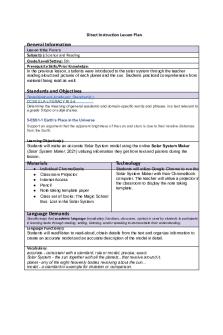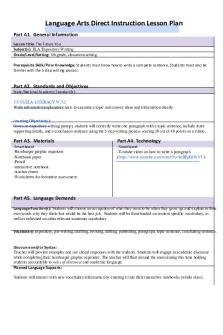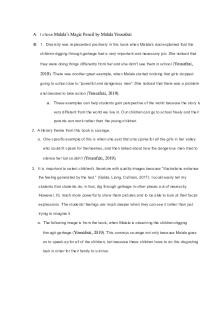This is the lesson plan --Graphing Task 1 Part D PDF

| Title | This is the lesson plan --Graphing Task 1 Part D |
|---|---|
| Course | Ratios & Proportions |
| Institution | Western Governors University |
| Pages | 8 |
| File Size | 325.4 KB |
| File Type | |
| Total Downloads | 8 |
| Total Views | 287 |
Summary
Lesson Plan for the Graphing Task 1. Completed with the lesson plan template that was provided. I hope that you find this helpful...
Description
Direct Instruction Lesson Plan Template
General Information Lesson Title: Graphing Subject(s): Ordered Pairs and Coordinate Planes Grade/Level/Setting: 5th Prerequisite Skills/Prior Knowledge: Plotting points on a number line graphing
Standards and Objectives State/National Academic Standard(s):
M.5.23 Use a pair of perpendicular number lines, called axes, to define a coordinate system, with the intersection of the lines, the origin, arranged to coincide with the 0 on each line and a given point in the plane located by using an ordered pair of numbers, called its coordinates. Understand that the first number indicates how far to travel from the origin in the direction of one axis and the second number indicates how far to travel in the direction of the second axis, with the convention that the names of the two axes and the coordinates correspond (e.g., x-axis and x-coordinate, y-axis and y-coordinate).
Learning Objective(s): Students will accurately graph multiple points onto a coordinate plane with at least 75% accuracy.
Materials
ELMO Projector Marker Vocab Cards Whiteboard Coordinate Plane Modeling sheets Exit Ticket Battleship template
Technology The teacher will be using the Elmo and projector to model for students.
Language Demands Language Function(s): Explain: Students will explain how and why they knew where to plot their points at when using
the coordinate plane. .
Vocabulary: Origin, coordinate plane, x-coordinate, axis, y-coordinate, and ordered pair,
Discourse and/or Syntax: Using number talks, students will be using oral language to discuss how they knew where each point would be graphed.
Planned Language Supports: Students will join together in a turn-and-talk with a partner. The teacher will be paying attention to conversations and asking some students questions. The teacher will also encourage the use of vocab words in student discussion.
Instructional Strategies and Learning Tasks
Anticipatory Set: Activity Description/Teacher The teacher will ask all students to come to the carpet for whole group discussion. Prior knowledge will be discussed through a turnand-talk. Vocabulary will also be discussed. The image below is the coordinate plane modeling sheet that the teacher will display under the ELMO to model for students. Students will also receive a copy of this for the teaching strategy. The teacher will be utilizing I do, We do, and you do.
Student Actions Students will have a turn-and-talk discussion of graphing. Prior knowledge will be activated.
Presentation Procedures for New Information and/or Modeling: Activity Description/Teacher First, students will be told that they will be graphing ordered pairs onto coordinate planes. The teacher will read students the objective. She will then tell the students that she wants them to take a few seconds to think of what they can remember about graphing from the previous years. This can include different types of graphs they have used. Once they have about 20 seconds to brainstorm, the teacher will tell them that they are going to turn-and-talk to their neighbor for about 30 seconds. She will ask for students to share out with the group what either they or their partner said. After prior knowledge is activated, the teacher will present the vocab words.
Coordinate Plane: A plane formed whenever two numbers intersect. Origin: The point (0,0) on a coordinate plane. This shows where the vertical and horizontal axis meet. Ordered Pair: Two numbers used to identify a
Student Actions Students will turn-and-talk to help trigger prior graphing knowledge. They will share with the group what either they said or what their partner said. Students will take part in verbally speaking the vocab word and definition to help commit it to memory. Going over the vocabulary will allow them to understand what the terms mean. This will increase student understanding when learning the lesson since vocabulary will be utilized.
point on the coordinate plane. X-coordinate: The first number in an ordered pair that specifies how far away, to the right of the y-axis, the point is. Y-coordinate: The second number in an ordered pair. It specifies how far above the xaxis the point is. Axis: A horizontal or vertical number line on a graph.
Students will say the vocab word after the teacher, and then repeat the definition back. These words will be displayed so that students can use them as a reference.
Guided Practice: Activity Description/Teacher Next, the teacher will turn on the ELMO and projector. The coordinate plane modeling sheets will be passed out. She will then begin modeling the I do portion of the lesson. She will place the modeling sheet under the ELMO. Looking at the displayed vocab words, the teacher will use the coordinate plane to point to where each word is located. She will then have all students write at the top of the sheet the ordered pair, (x,y). The teacher will explain to students that x always comes first. A way to remember this if they are unsure is to think of the fact that alphabetically, x comes before y. Out of the eight problems, for I do, the teacher will model the first two problems in each column. We do will take place with the remaining four. Example of the teacher modeling the first two problems.
As you can see, I first need to write the
Student Actions Students will participate in the class instruction. They will answer questions such as:
“Which axis is the x?” “Which axis is the y?” “In my ordered pair, which number is the x? Which number is the y?” “Where is the origin?” “Where do I need to start at on my coordinate plane?” “Which step comes next?”
ordered pair for point T. I am going to take my pencil and put it on point T. My x-axis is this bottom, horizontal axis. So all I need to do, is drag my pencil straight down. I will then be able to see what x coordinate goes with T. After dragging my pencil down, I hit four. Now, I will go ahead and fill in the x blank on my paper. Do not fill yours in yet, I will give you time when I am finished. I am going to do the same thing to find my y coordinate. I am going to put my pencil on point T, and drag it directly to the left to figure out what my Y is. I can now see that y=4. Both my x and y are four— (4,4). The other type of problem that I have here is where I have to graph the point myself. It wants me to graph (0,1). Since I know x is first, I will first find zero on the x-axis--which is the bottom horizontal one. Once my pencil is on the zero, I can count up however many lines my y is. Since my y is one, I am going to move my pencil up one space. This is where my point goes.
After modeling four problems, the teacher would begin the We do phase the exact same way. The only difference is that students would be imitating her movements and participating in questioning.
Vocab terms would be reviewed before independent practice. Independent Student Practice: Activity Description/Teacher Students will now receive their eight question Exit Ticket.
Student Actions Students will complete their Exit Ticket independently to showcase comprehension.
Culminating or Closing Procedure/Activity: Activity Description/Teacher Once students have turned in their exit ticket, they will grab a battleship template. It will ask them to plot 4 points beside each other, 2 sets of 3 points beside each other, and 2 points beside each other. This will represent their “ships”. They will partner up with someone else that is finished to play.
Student Actions Students will start the battleship coordinate plane game with a partner.
This game allows the concept to be reinforced. Students will get to verbally speak ordered pairs. While students are working, this will be a great time for the teacher to walk around and provide extra assistance as needed.
Differentiated Instruction
Gifted and Talented: Gifted/talented students will receive extra points to graph.
EL: ELL students will be provided with a copy of the vocab words and definitions in their first language. There will also be pictures included with each vocab word. Students with Other Special Needs: Students with special needs will receive modified work—they will only be expected to complete half of the graphing problems. These students will also be provided with extra time.
Assessment Formative The teacher will walk around the room during the turn and talk to see what students remember about graphing.
During guided practice, the teacher will ask students to give a thumbs up or down to show understanding.
At the end of the We Do phase, the teacher will have students try a problem on their own. She will walk around and monitor student work.
Summative At the end of the lesson, students will receive an exit ticket. The exit ticket will allow the students to showcase their understanding of equivalent fractions with at least 75% accuracy. They will be able to show how they got their answer. There will be eight questions on the exit ticket worth one point each.
U
N
K
L
Write the ordered pair for: N= _ , _ K= _ , _ U= _ , _ L= _ , _
Plot the following points on the coordinate plane: (2,1) (6,2) (0,5) (4,7)...
Similar Free PDFs

Task 1 - Lesson Plan
- 6 Pages

Task 1 - Lesson Plan
- 8 Pages

Lesson Plan task 1
- 6 Pages

BDM2 Task 1 lesson plan
- 15 Pages

Lesson Plan / task
- 7 Pages

Lesson Plan - - Task 2
- 7 Pages

Task 1 Math Tools lesson plan
- 13 Pages

C732 Task 1 Lesson Plan - Passed
- 6 Pages

HXM1 Task 1 pdf - lesson plan
- 5 Pages

Geometry Task 2 Lesson Plan
- 7 Pages

C365 Lesson Plan Task 1.docx
- 8 Pages
Popular Institutions
- Tinajero National High School - Annex
- Politeknik Caltex Riau
- Yokohama City University
- SGT University
- University of Al-Qadisiyah
- Divine Word College of Vigan
- Techniek College Rotterdam
- Universidade de Santiago
- Universiti Teknologi MARA Cawangan Johor Kampus Pasir Gudang
- Poltekkes Kemenkes Yogyakarta
- Baguio City National High School
- Colegio san marcos
- preparatoria uno
- Centro de Bachillerato Tecnológico Industrial y de Servicios No. 107
- Dalian Maritime University
- Quang Trung Secondary School
- Colegio Tecnológico en Informática
- Corporación Regional de Educación Superior
- Grupo CEDVA
- Dar Al Uloom University
- Centro de Estudios Preuniversitarios de la Universidad Nacional de Ingeniería
- 上智大学
- Aakash International School, Nuna Majara
- San Felipe Neri Catholic School
- Kang Chiao International School - New Taipei City
- Misamis Occidental National High School
- Institución Educativa Escuela Normal Juan Ladrilleros
- Kolehiyo ng Pantukan
- Batanes State College
- Instituto Continental
- Sekolah Menengah Kejuruan Kesehatan Kaltara (Tarakan)
- Colegio de La Inmaculada Concepcion - Cebu




